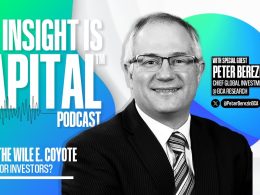by Jeremy Ryan, Wells Fargo Asset Management
Today’s Daily Advantage comes to us from guest writer Jim Durning.
Major stock indexes on Friday in the U.S. were flat to mildly positive. The Dow added more than 18 points, with 16 of its 30 components advancing; the S&P 500 Index was off less than a point; and the Nasdaq added almost 14 points. Decliners led advancers by about 10 to 9 on the NYSE while advancers led decliners by about 9 to 8 on the Nasdaq. The prices of Treasuries strengthened. Gold futures gained $5.70 to settle at $1,317.10 an ounce. The price of crude oil decreased $1.54, settling at $43.16 a barrel.
In earnings news:
- Infoblox Inc. reported it was accepting acquisition bids, and the security-software company beat earnings expectations. The company reported a quarterly profit of 8 cents a share. Analysts expected earnings of 7 cents a share. The company’s stock (BLOX) gained 3.17% in trading.
- Campbell Soup Co. reported a loss of $37 million for its fiscal fourth quarter compared with income of $43 million during the same time period a year ago. Company shares (CPB) fell 6.27% in trading.
- Salesforce.com Inc. announced better-than-expected profit and revenue but tempered projections for the current quarter. The company reported net income of $229.6 million on sales of $2.04 billion, with an assist from a one-time tax windfall from its acquisition of Demandware Inc. Salesforce raised full-year revenue guidance and slightly lowered guidance for the current quarter. Salesforce (CRM) shares fell 4.42% in trading.
In other business news:
- Global Purchasing Managers Index surveys found generally increasing manufacturing activity in August, reported The New York Times. Manufacturing in China and Britain were stronger. In Japan, the reading moved slightly higher. Growth in the eurozone slowed with much of the expansion focused in the north: Germany, the Netherlands, and Austria. Readings were weaker in France, Italy, Spain, and Ireland.
- The Institute for Supply Management said its U.S. manufacturing index in August fell to 49.4% from 52.6% last month, below the consensus expectation for a 52% reading. Any reading below 50% indicates contraction, and the index was below that level for the first time since February.
*****
Video killed the radio star and music streaming, it appears, is killing the advertising jingle. Once ubiquitous and often annoyingly unforgettable, advertising jingle is quickly becoming a relic of another time and culture.
For millions of Americans, the advertising jingle is as much a part of the soundtrack of their lives as popular music and television theme songs. The jingle is such an integral part of their musical sensibilities that they can finish lyrics without hesitation.
- Ten million strong … and growing.
- And away go troubles … down the drain.
- Hold the pickle, hold the lettuce … special orders don’t upset us.
- Plop, plop, fizz, fizz … oh, what a relief it is.
In many cases, the jingle was so memorable, we didn’t even need to hear the product name to know what it was. Alas, those advertising earworms are few and far between now.
The Atlantic recently reported that a 1998 survey of television commercials by the American Association of Advertising Agencies counted 153 jingles in a sample of 1,279 national 30-second ads. By 2011, the last year the survey was produced, those numbers dropped to only 8 original jingles out of 306 commercials. Full disclosure: The number of national 30-second ads became rarer during that time but, nevertheless, the decline in frequency is notable.
Today, advertisers are licensing existing music from recording artists to the tune of $355 million in revenue last year, says a recording industry trade group. For musicians who are taking home $0.0011 for every time one of their songs plays on a streaming service, the potential payday of selling a song to hawk tires, for example, must be pretty enticing.
The Atlantic reported that the beginning of the end of advertising jingle is traced back to the rise of the counter culture, a trend of nonconformity, and disdain for mass consumption in the 1960s. In 1971, advertising brought consumers “I’d like to buy the world a (well-known soda),” which sounded enough like a pop song to climb the record charts, move gallons of soda, and cement the strategy of commissioning songs for commercials. During the 1980s, Michael Jackson, Run-DMC, and Madonna adapted existing or composed original works for advertisers.
Advertisers augmented their patronage of original music to sell their products by licensing well-known tunes that would resonate with members of their markets (think four raisins singing “I Heard It Through the Grapevine”). Musical artists responded in kind. For example, electronic musician Moby licensed every song on his 1999 album “Play” for a number of companies. In turn, the album went double platinum, creating the conundrum, which came first, the commercial or the hit?
There was a time when licensing music might have been considered selling out (Neil Young’s 1988 “This Note’s for You” called out others on it). Today, licensing a song or aligning with a brand is considered “an essential move,” says one advertising executive. That leaves one to wonder whether there is any distinction between a song for art’s sake or one for commerce’s sake, or can both legitimately claim to say, “It’s the real thing, baby.”
Copyright © Wells Fargo Asset Management















